Greetings from Vienna
Guten Tag…or rather…Grüß Gott. In Germany you always greet someone with Guten Tag, but in Austria, the preferred expression is Grüß Gott — which roughly means “God bless you.” To start your day in Austria, order eierspeis und semmel (eggs and bread), whereas in Germany, it’s rührei und brötchen. I love languages and how they reveal so much about a culture. Remember, Austria was part of the Austro-Hungarian Empire, and not part of Germany, despite German being its official language.
I am here in Vienna directing Rebecca, a musical adaptation of the Daphne du Maurier novel, with words and music by Michael Kunze and Sylvester Levay. Even if you’ve not read the book, I suspect you’ve seen the psychologically-chilling film version by Alfred Hitchcock starring Laurence Olivier and Joan Fontaine. I directed the world premiere of Rebecca here, at the Raimond Theater, in 2006, so I am delighted to be back for this new production. The most difficult scene to execute is the burning of Manderley, where Mrs. Danvers sets fire to the English manor house. (Imagine Downton Abbey burning down on stage!) If you are traveling to Vienna, Rebecca opens tonight. The Raimond Theater website has a great video trailer and photos from the production — including of the fire!
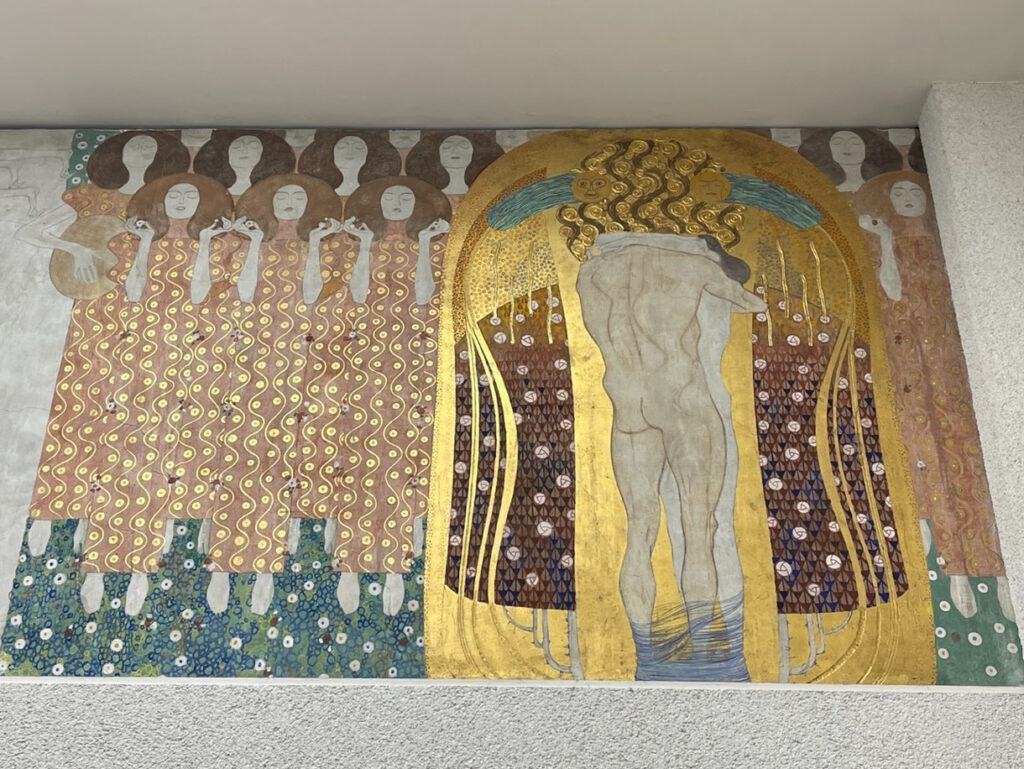
A section of Gustav Klimt’s “Beethoven Frieze,” painted in 1901 for the 14th Vienna
Secessionist exhibition in celebration of the composer, which I came to view this month. It is now on permanent display in the Vienna Secessionist Building in a specially-built, climate-controlled basement room. The Weiner Secession, or Union of Austrian Artists, was an art movement related to Art Nouveau formed in the late 19th century by Josef Hoffmann, Koloman Moser, Otto Wagner and Gustav Klimt. The building was designed as a venue for their exhibitions. Because Klimt intended the frieze to be temporary (just for the duration of the exhibition), it was painted on the walls with light materials. Hence it was moved to the special room.
The grand tour.
Today I plan to take you around Vienna, Bratislava and Budapest to share with you some more of my favorite sites. But before starting the grand tour, I want to begin with a heartfelt thanks to everyone associated with The Glimmerglass Festival.

A tip of the hat from Rome. Photo by Jackson McBryde
With gratitude for the last twelve years. The Glimmerglass Festival business year ends September 30, and as a result, I am just days away from the official conclusion of my tenure as Artistic & General Director. It is a ginormous understatement to say how grateful I am for the opportunity to lead this company over the past 12 years.
Guides, collaborators, friends, family. There are so many people who have made my time as Artistic & General Director of Glimmerglass memorable — from the singers, directors, designers, stage crews, craftspeople, and musicians, to the children, families, audiences and the many supporters who became friends along the way. What has truly anchored my life at Glimmerglass has been the staff and board who enthusiastically applauded my hopes, dreams and all of our productions and programs. These amazing individuals — including those who have moved on since I started here — have been my guides…my collaborators…my friends…my second family.
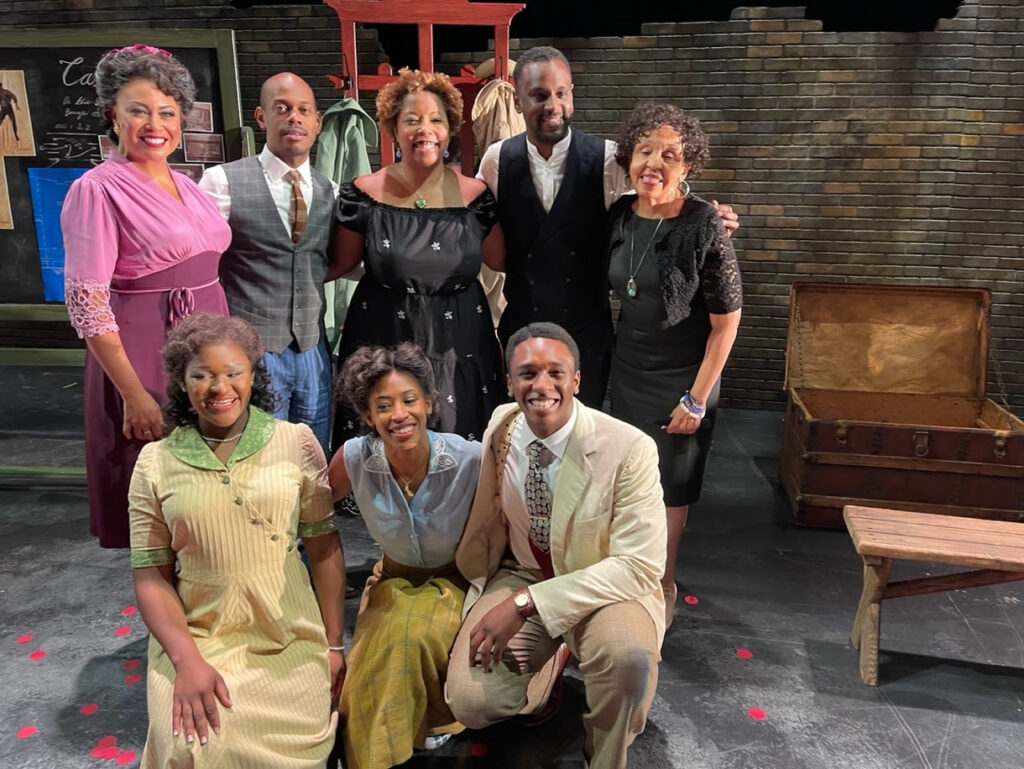
Taken on stage before the opening of The Passion of Mary Cardwell Dawson in August. I was particularly moved to have this special commission — which was representative in many ways of some of the new directions we took the company over the past 12 years — be the last opening of my final season. Front row l-r: Young Artists V. Lawal, Taylor-Alexis DuPont, Jonathan Pierce Rhodes. Back row l-r: Alyson Cambridge, Kevin Miller, director Kimille Howard, composer Carlos Simon, playwright Sandra Seaton.
It takes a village. One person does not lead a company. We are an ensemble in which everyone plays a part. The artistic and music staff collaborates equally with operations, finance, production, fundraising and marketing. Every new idea, detail, and programmatic concept are debated and meticulously considered from all perspectives. Together we have produced more than 50 new productions, many of which have gone on to theaters across the United States and as far away as Oman, Australia and South Africa. We have stretched the boundaries of opera both musically and dramatically and asked hard questions about our role in the arts. With the staff’s creativity, energy, talent, thoughtful observations and at times, ‘hard-knock’ experiences, we have reconfigured how we approach our work and operate in the face of challenges like COVID-19, inflation, and the need to address social change.

Shortly before I left for Vienna, my wife Faith (who, by the way, is also a pilot!) took our son Jackson and me up for a fly-over of the theater. From the earliest days of the Festival under founders Peter Macris and Charles Schneider, to the glorious years under my dear friend and mentor, Paul Kellogg, Glimmerglass has perpetually evolved and flourished with each administration. I am honored to end my tenure having followed in the footsteps of these extraordinary gentlemen who poured their hearts, ideas and passion into creating and evolving this enduring Festival.
Rob and a brilliant future. This has been an amazing journey…and it’s far from over. Faith, Jackson and I have made a life in Cooperstown, and the Festival will continue to be part of it in so many ways. As Glimmerglass looks to the future, I am proud to be leaving the Festival on solid footing. There are many challenges ahead, but we have weathered many storms, and the future is bright. I am especially pleased that Rob Ainsley was selected as my successor. His exceptional musical knowledge, endless energy, personal charm and phenomenal sense of humor (which those of you who attended this summer’s final week of performances had the joy of experiencing if you heard his witty curtain speeches) will carry this company far in the coming years.
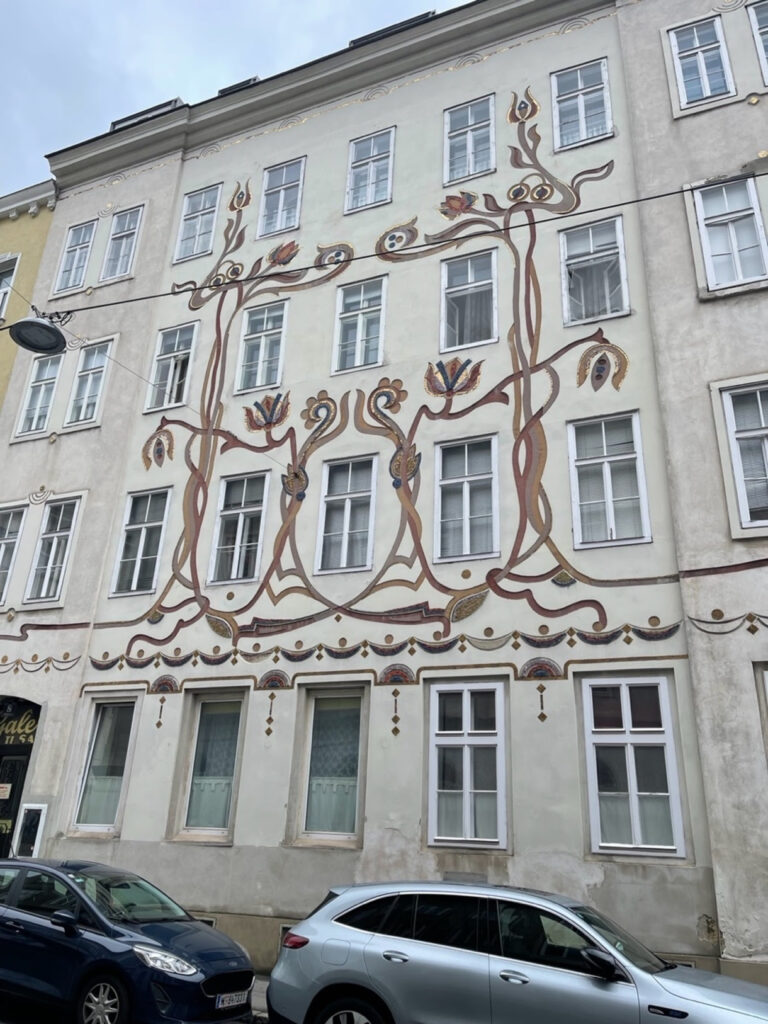
A beautifully adorned apartment building, one of the many examples of Art Nouveau found throughout Vienna.
Jugendstil=Art Nouveau=Vienna. Everywhere you look, Vienna is full of Art Nouveau (in German, Jugendstil). There are design flourishes on the facades of buildings, in galleries, and even, famously, in the first and most beautiful of the city’s underground public lavatories on The Graben in Vienna’s city center. Art Nouveau dominated Vienna at the turn of the 20th century until around the 1920s. Among the most famous Nouveau artworks is Gustav Klimt’s painting “The Kiss,” that hangs in the Österreichische Galerie Belvedere. There is so much controversy surrounding this painting, it is almost worthy of an opera. Who really owns it? Should it be restored? These are complex questions, but over the past few weeks that I’ve been here, I’ve just been enjoying the small pleasures of stumbling upon Art Nouveau treasures all around me.
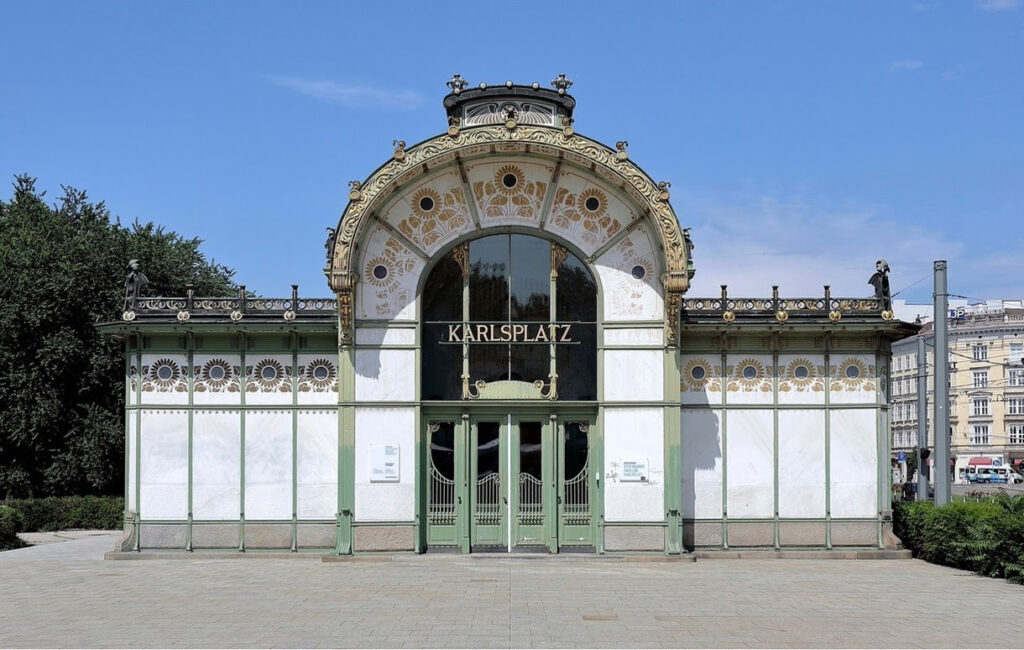
The Karlsplatz Subway Station. I love that I use this subway station, designed by Otto Wagner, to get to work each day.
Form vs. Function. There is SO much about Vienna that I could write about, but I only have room for a few examples. One of the important architects of the Vienna Secession Movement whose work I greatly admire is Otto Wagner. Wagner was an Austrian architect, furniture designer and urban planner. He was one of the leading members of the Vienna Secession Movement, which I referenced above. Many of his works are found throughout Vienna and illustrate the rapid evolution of architecture during the period. Beginning in 1898, with his designs of the Vienna Metro stations, he started incorporating floral elements and more of a Nouveau and ultimately Secessionist style. His later work, 1906 until his death in 1918, involved geometric forms and minimal ornamentation to better express functionality. His style is often considered a predecessor to modern architecture. You can find some of his drawings and furniture in MOMA in NYC.
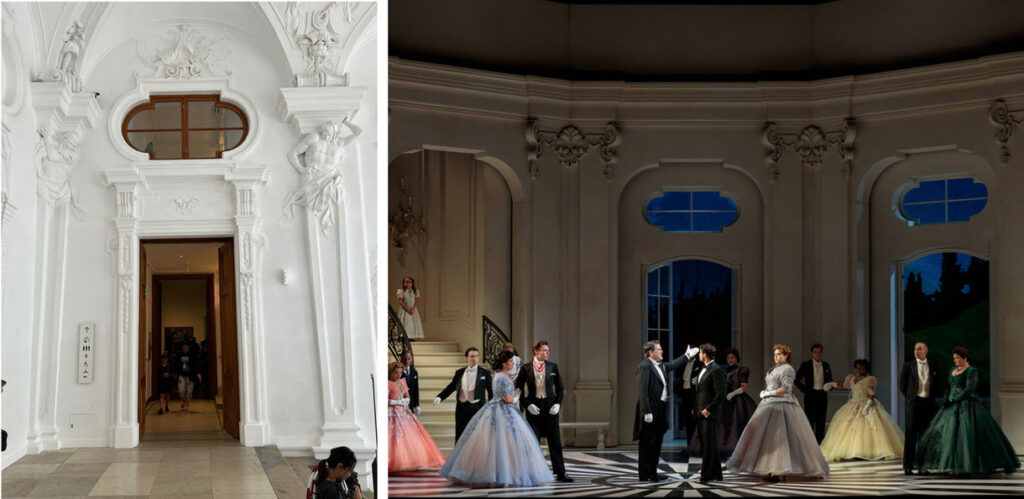
This passageway on the left is part of The Belvedere, a historic complex of two Baroque palaces, an orangerie and stables set in a beautiful Baroque park. It was the inspiration for our Sound of Music set at Glimmerglass this past summer.
The Sound of Music production photo by Karli Cadel.
Guess where this is? Although The Belvedere is a well-known, popular tourist attraction, this specific doorway may not be what visitors typically choose to photograph as a keepsake. But Peter J. Davison, the set designer for The Sound of Music (and many other Glimmerglass productions), was inspired by it and referenced it in the five arches — particularly the stage right and stage left doors in the show’s scenery. Designs often emerge this way; seeing something that resonates with the story and imagining how it can be translated for the stage. Our challenge as we were preparing the show more than a year in advance was to figure out a way to have a set that would convey the mountains, the abbey, the house, the bedroom and other locations. The notion of the arches was one way to contain all these locations, and still convey the world of Salzburg where the action takes place.
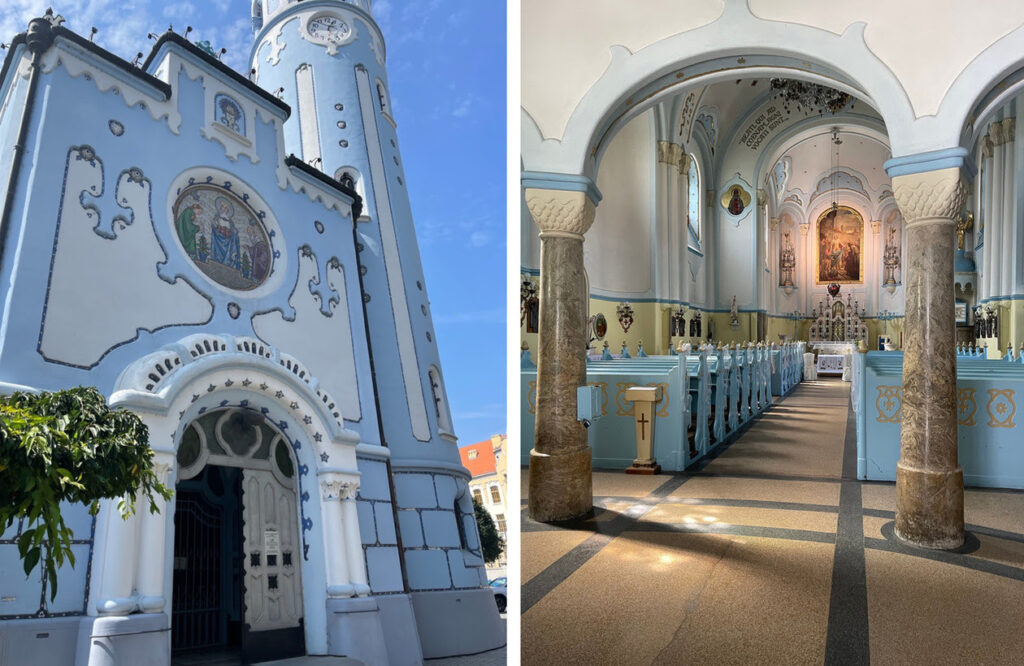
Church of St. Elizabeth, known as Blue Church, in Old Town Bratislava, my favorite site in Slovakia.
On to Bratislava. When Faith came to visit, we decided to drive to Budapest for the weekend, but because we had never seen Bratislava we decided to stop there on the way. There is so much to see in this Slovakian capital, and I look forward to returning at some point. Like Vienna and Budapest, it sits on the long and winding Danube River, high up on a hilltop with the requisite castle. We were most interested in visiting the many Baroque churches and the Heydukova Street Synagogue, which was designed completely in the Cubist style by the local Jewish architect, Artur Szalatnai. But what became my favorite site was the Blue Church. It was originally part of a school, and everything about it is blue — the tiles, mosaics, the interior, and exterior all in the Art Nouveau, Hungarian-Secessionist style of architect Ödön Lechner.
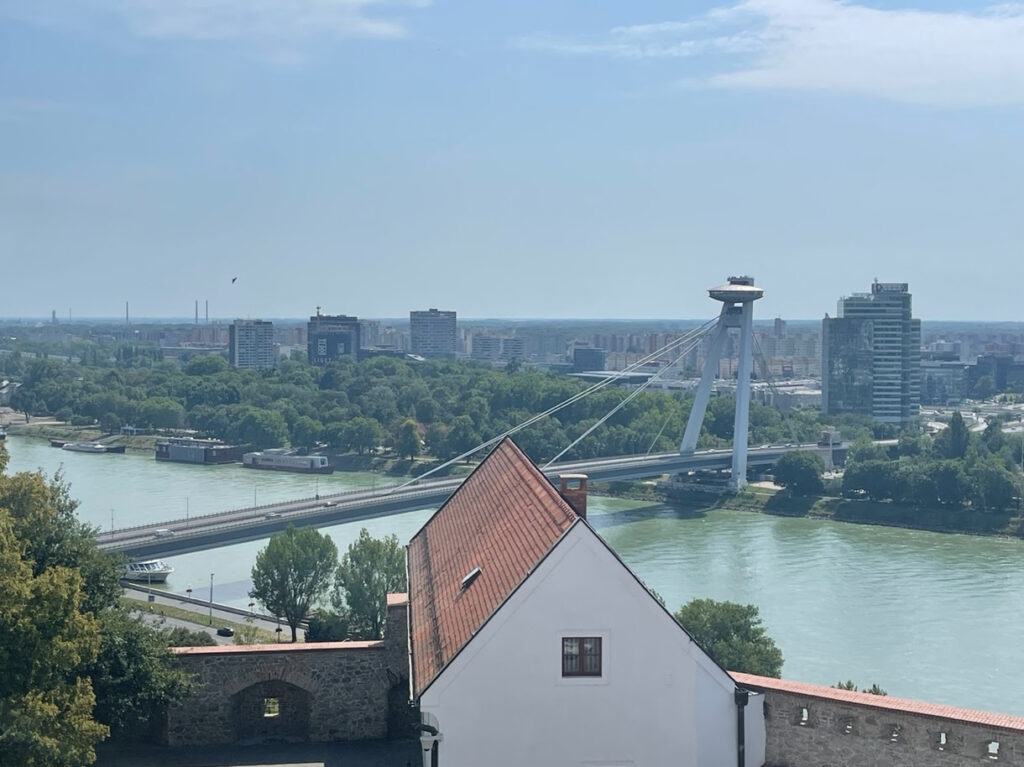
As in so much of the former Eastern Bloc, there is a lot of Brutalist-inspired architecture in addition to well-preserved historical buildings. Among such sites is this unusual bridge over the Danube, which the locals have dubbed the UFO Bridge (I’m sure you can guess why). It is the world’s longest bridge to have just one pylon and one cable-stayed plane.
And then to Budapest. Once we left Bratislava, we drove on to Budapest where the weather was perfect and where we felt the distant past come alive. Although we only had 36 hours, we hired a guide and a car and ran around nonstop in both Buda and Pest. The things that were the most interesting to me were the synagogue and the Ruin Bars.

The Moorish Revival-style Dohány Street Great Synagogue in Budapest is the largest synagogue in Europe and seats 3,000 people. It is the center of Hungary’s Neolog Judaism. Interestingly, the Central Synagogue in Manhattan on Lexington Avenue is a near-exact copy of the Dohány Street Synagogue! Theodor Hertzl, the Austro-Hungarian Jewish lawyer, journalist, playwright, and political activist known as the father of modern Zionism, was born inside the adjoining house.
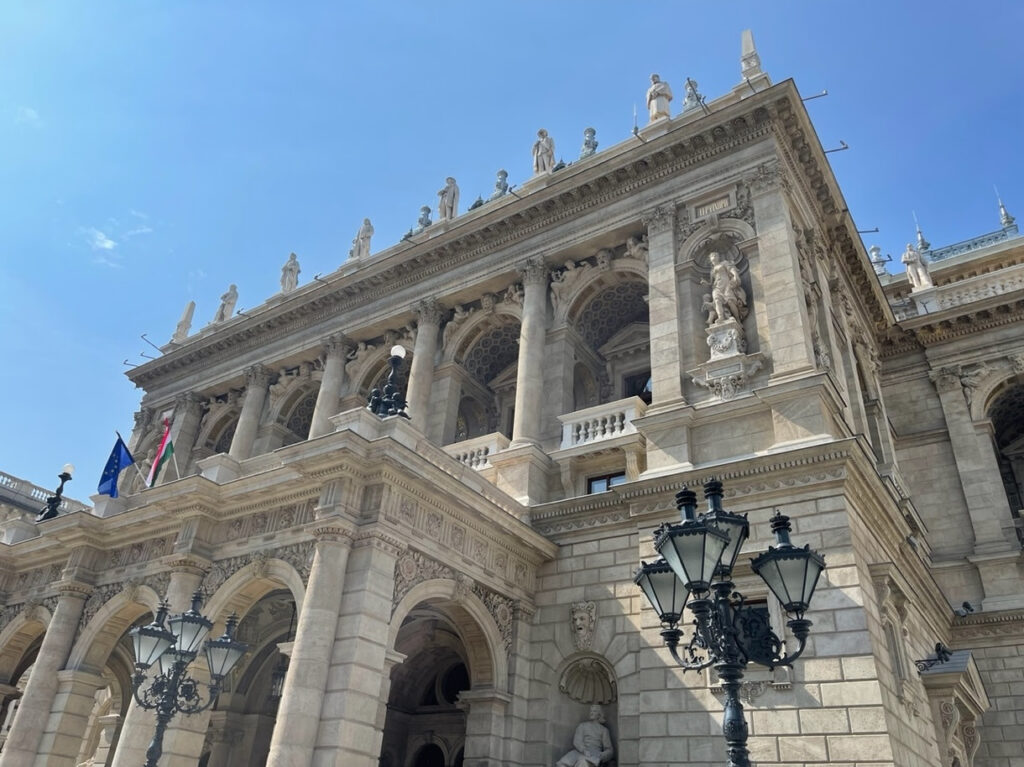
And of course, while in Budapest, I had to stop by the neo-Renaissance Hungarian Royal Opera House, which was funded by Franz Joseph I of Austria-Hungary and opened in 1884.
And I bet you saw this coming… Wiener Schnitzel
This particular edition of my Traveling iPad would not be complete without a recipe for Wiener schnitzel, one of the easiest and fastest things to cook. Traditional Weiner schnitzel uses veal but you can also use pork, chicken or even turkey. The main thing, as always, is proper preparation and using the very best ingredients.
Boneless veal cutlets (about 1/3-1/4 of a lb. for each serving)
Flour
2 eggs (room temperature)
Homemade breadcrumbs with dried spices of your choice (I like to pulse them a little but so they are not too big)
Salt/pepper/a little paprika
Vegetable oil or lard (better for frying)
Lemon slices and parsley
Cast iron frying pan
- Pound the cutlets until about ¼ inch thick. Trim the edges and give the trimming to your dogs (Rome and Rex love it when I make Wiener schnitzel.)
- Season the cutlets with salt, pepper and paprika.
- Prepare three shallow bowls: 1 for eggs whipped up, 1 for flour, and 1 for breadcrumbs.
- Dip the cutlets in flour, then eggs, then breadcrumbs, making sure the crumbs stick all over.
- Put in hot oil in the frying pan so it is just floating and cook about 3-4 minutes a side
- Serve immediately with fresh lemon, parsley, potato salad and super-chilled Austrian white wine. If you do it like this, it will not be greasy or heavy, I swear, but work fast!
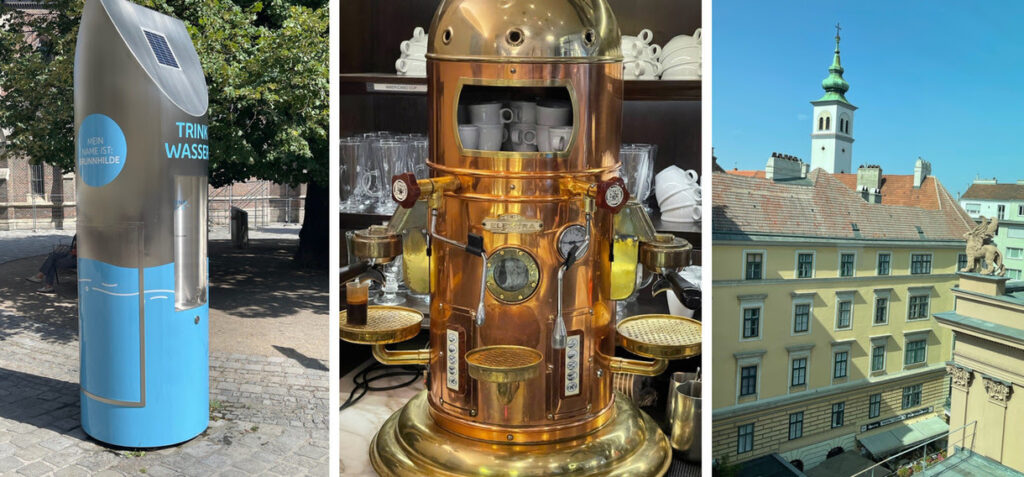
And a few additional eccentric glimpses of Vienna: a public water station, an Elektra coffee machine (which is made in Italy, but makes great coffee to have alongside some of those Viennese pastries), and the view from our rehearsal room.
Happy new year. Before signing off, as we head into the Jewish New Year, I want to extend all best wishes to those who celebrate Rosh Hashanah and Yom Kippur. May the year ahead bring you health and happiness.
And so, it is with optimism and good cheer that I pass the reins over to my dear friend and much-admired colleague, Rob Ainsley, and bid a warm auf wiedersehen to the amazing staff of The Glimmerglass Festival. I look forward to seeing many of you throughout the year, and being in the audience with you at Glimmerglass next summer. (Remember Ticket Packages for the 2023 Festival go on sale October 3!)
Although I will no longer be on staff, Faith and I remain devoted Festival supporters. With our fiscal year ending on September 30, if you have not already done so, I hope you will consider a gift to Glimmerglass. This is a remarkable company, with exceptional, innovative programming that has endured and evolved over more than four decades. Please join us in getting behind our new leadership and help ensure the glorious season ahead.
With my enduring gratitude,
‘Cesca
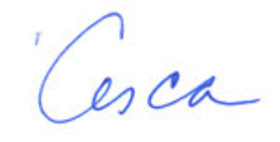
Francesca Zambello
P.S. If you are in D.C., please let me know and join me at performances at Washington National Opera, where I remain as Artistic Director. This fall we have performances of ll trovatore and Elektra, with casts including many from Glimmerglass — Christine Goerke, Latonia Moore, Raehann Bryce-Davis, Alexandra Loutsion and Alexandria Shiner. In January we are presenting The Passion of Mary Cardwell Dawson, and in March, I am so proud that we will be bringing Blue to the Kennedy Center, with much of the original cast from the Glimmerglass world premiere.


